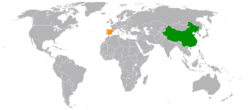China–Spain relations
 | |
China |
Spain |
|---|---|
China–Spain relations have existed since the 16th century. Relations between Spain and the People's Republic of China were established in 1973.[1]
History
Contact between China and Spain first occurred between Ming dynasty China and the Spanish ruled Philippines.
Spain fantasized about taking over China.[2][3][4]
When the Chinese pirate Limahong attacked Manila in 1574, officials in Fujian province were willing to let the Spanish establish a trade port on an island south of Xiamen in return for Limahong's capture. However, the governor of the Philippines at the time did not respond favourably, and the offer came to nothing when Limahong escaped from Manila.[5]
In 1598, Cantonese officials allowed Spain to trade in El Piñal, a port in the Pearl River Delta near Macau. The Portuguese in Macau reacted violently, chasing away the Spanish from the area via force of arms in 1600.[5]
The Qing dynasty and Spain had diplomatic relations.
In 1927, a treaty recognizing extraterritoriality was signed between the Kingdom of Spain and Chiang Kai-shek's Nationalist government. The Spanish consul general in Shanghai was also the minister plenipotentiary to China.[6] The Republic of China had diplomatic relations with Spain under Franco.[7]
Spanish relations with the People's Republic of China began in 1973 after both countries were still reeling from the aftermath of civil wars.[1]
Relations have gradually improved with official state visits between the two countries and various exchanges.[8] Spain hosted Expo 2008 which China was a participant at, and China then hosted Expo 2010, where Spain had a pavilion.
Bilateral relations
The volume of trade between the two countries has grown considerably in recent years. Total trade stood at $7.2 billion USD in 2004, and had increased to $22.7 billion by October 2008.[1]
As a consequence, China has become Spain's sixth largest trading partner.[1]
Recently, Spain held the rotating EU presidency from Jan 1 to June 30, 2010, and indicated they would support a lift in the EU Arms embargo to boost two-way trade because in 2008, China's exports to the EU were 248 billion euros ($357 billion), but imports were only 78 billion euros.[9] This could improve trade between the EU and China by allowing China to import higher technology goods for which the Europeans are known.[9]
Trade
While most cargoes are shipped between China and Europe (including Spain) by sea, there are direct container trains running from Yiwu (Zhejiang Province) to Madrid as well.[10]
See also
References
- 1 2 3 4 China-Spain relations see steady growth
- ↑ Eugenio Menegon (2009). Ancestors, Virgins, & Friars: Christianity as a Local Religion in Late Imperial China. Harvard University Press. pp. 11–. ISBN 978-0-674-03596-6.
- ↑ Shirley Fish (18 May 2011). The Manila-Acapulco Galleons : The Treasure Ships of the Pacific: With an Annotated List of the Transpacific Galleons 1565-1815. AuthorHouse. pp. 96–. ISBN 978-1-4567-7543-8.
- ↑ http://www.samuelhawley.com/imjinarticle3.html
- 1 2 Sousa Pinto, Paulo Jorge de (2008). "Enemy at the Gates - Macao, Manila and the "Pinhal Episode" (end of the 16th Century)". Bulletin of Portuguese - Japanese Studies. 16: 11–43.
- ↑ Ruis-Castillo, Carlos Garcia (25 February 2009). Los fondos de las representaciones diplomáticas y consulares de España en China conservados en el Archivo General de la Administración: su contexto (in Spanish). Retrieved 22 December 2017.
- ↑ Franco Wishes Pres. Chiang Success, Taiwan Today, December 19, 1965
- ↑ people.com.cn, June 10, 2008, Spain, China pledge to deepen relations
- 1 2 Zhang Jin, 2010-01-21, (China Daily), Spain could ask EU to lift arms ban on China
- ↑ Shepard, Wade (2016-01-28), "Why The China-Europe 'Silk Road' Rail Network Is Growing Fast", Forbes
External links
- Spanish Embassy in Beijing, China (in Chinese) (in Spanish)
- Embajada de la República Popular China en España (in Chinese) (in Spanish)
- Chinese Embassy in Madrid,Spain (in Chinese) (in Spanish)
.svg.png)
.svg.png)